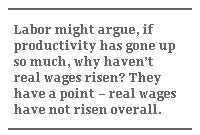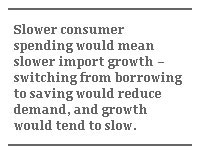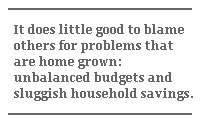Why “Fair Trade” Could Backfire for the US
Why “Fair Trade” Could Backfire for the US

more so than trade, and protectionist measures could do more harm than good
MEDFORD, US: If US manufacturing employment is in decline, who is to blame? The most common response, trade, and the popular remedy, protectionism, are, in fact, wrong. But with pro-labor Democrats in control of both chambers in the US Congress, there is risk that the wrong remedy will be adopted, further deepening the problem. Yet, past experience shows that some immediately unpopular policies like reining in expenditures and encouraging saving could turn the situation around.
US manufacturing output has been growing at about 3 percent a year since 1979. Up to 2000, manufacturing actually grew a little faster than overall output; since then it has grown slower. However, US manufacturing employment peaked in 1979 at 19.4 million and has fallen irregularly to about 14 million now. Whereas in 1979, more than one in five workers were in manufacturing, now it is about one in ten. Many blame this job decline on big trade deficits and free trade. Labor, more powerful now with Democratic majorities in both the US House and Senate, speaks of “fair trade” and wishes to increase trade barriers to raise wages and create “good” jobs in manufacturing.

Most economists do not think this strategy will work, and indeed they believe it would do more harm than good. They argue that increasing factory productivity accounts for most of the decline in manufacturing employment. In 2005 prices, a 1979 worker produced $40,000 in manufacturing output while in 2005 the output per factory worker was more than $106,000. As technology advanced, factories could make more with fewer workers. An estimate by two well-regarded economists in 2005
Labor and others might argue, if productivity has gone up so much, why haven’t real wages also risen? They have a point – real wages have not risen overall or in manufacturing. Instead, they are down slightly since 1979, which itself was lower than in some previous years. One reason is that total worker compensation includes not only wages but also fringes such as health insurance, and that has gone up rapidly. Real compensation per hour rose from an index of 90 in 1979 to 120 in 2005. This is an increase of 1/3, or a little over 1 percent year, much less than the 4 percent annual rise in manufacturing productivity.

It is likely that the changes in technology have increased the demand for capital relative to that of labor. Trade, too, has weakened the bargaining power of most labor, but is probably a secondary factor. For example, Boeing as a company is doing well and will soon start production of its fast-selling “787” plastic aircraft. Yet only a few hundred workers in the Seattle area are putting it together. Instead of millions of rivets, only a few sections are fitted together. The plane is cheaper to build and fly, cleaner, quieter and more comfortable for passengers. Yet even counting the global subcontracting, much less labor is used.
It certainly makes sense for labor to keep training and be flexible, but if there is a shift in the relative shares of capital and labor, the only way to make workers better off without creating larger offsetting costs is to have workers own more capital. They could do this through “encouraged” pension savings invested in index funds.

Switching from borrowing to saving would reduce demand and growth would tend to slow. The Federal Reserve would cut interest rates to maintain full employment. Those who borrow yen at low interest rates and buy dollar bonds would cut back this “carry trade” as it grew less profitable. This would tend to weaken the dollar relative to the yen and many other currencies. A weaker currency, with low inflation, means higher exports and lower or slower growing imports. It might also mean lower foreign bond rates, higher foreign equity prices, and more growth overseas. This too would boost US exports. However, pessimists would argue that China would not join this adjustment and so the entire effort would not work.
It is probably true that getting the Chinese currency to appreciate would not help reduce the US trade deficit much. China has managed to hold onto labor-intensive markets while also moving up market, including aircraft parts and microchips in its exports, even while gently appreciating its currency and raising workers’ wages. Estimates of productivity growth in manufacturing are as high as 15 to 20 percent a year!

Besides allowing the dollar to depreciate as interest rates are lowered to keep demand adequate, the US could try to fix its health care system. The US spends more than $6000 on health care per person, or about 16 percent of GDP, even though 40 million citizens are uninsured. Most other rich nations, many with longer life expectancies and better coverage of their populations, spend 8 to 12 percent of GDP. Since most health insurance except Medicare is through employers, the costs of health care are equivalent to a wage tax that is destroying jobs. Old-line industries, such as autos and steel, find it especially hard to compete with their legacy costs of retirees. If a more efficient and rational system could be pushed through the resistant lobbying of the interest-groups, manufacturing would shed a huge handicap. The fact that life expectancy in the US is below that of Costa Rica, which spent 9.3 percent of its GDP or $743 per capita in 2002, might at least create some embarrassment.
It does little good to blame others for problems that are mostly home grown. In the recent past, the US managed to have balanced budgets, positive household savings and lower spending on health care. If we combine these with a sustainable exchange rate, much that is wrong will be right. A bad economic diagnosis and the wrong medicine would make everyone sicker.
1 "Don't blame trade for US job losses," by Martin Neil Bailey and Robert Z. Lawrence, McKinsey Quarterly, 2005, #1. They focused on the 2000 to 2003 period when trade deficits were growing. From 2001 to 2006, real consumption grew 17 percent, real exports by 26 percent and real imports by 34 percent. The authors blamed a strong dollar and productivity growth for most of the job losses, but also argue for keeping domestic demand strong. A weaker dollar would help do this by shrinking the trade deficit. When the dollar weakened after 1985, the US export/import ratio rose from 59 to 83 percent from 1986-91.
2 Some economists argue that measured inflation is higher than actual inflation, but only by 1 percent a year or so. Even if inflation were lower and real wage growth higher, the difference with productivity would remain.
3 Research has shown how a positive default setting (a worker can change it, but needs to take the initiative to do so) of having a 401-K tax-advantaged retirement savings plan leads to a high participation rate. A negative default (a worker must opt in) has a much lower participation rate. Employer matching makes the choice even more attractive. As assets accumulated, most workers would have some capital income.
4 "Why China's exporters are striking it rich," Financial Times, March 8, 2007, p. 11. The column by Guy DeJonguieres argues that domestic reforms have to be combined with yuan appreciation.
5 The data come from the UNDP's Human Development Report 2005, from Table 3 for spending and Table 10 for life expectancy. The Costa Rican health spending is in PPP terms, which is higher than if it were evaluated at the exchange rate.
6 Representative Barney Frank has suggested tying fast track authority to a "grand bargain" that would improve the situation of working people. If health care were part of his bargain, that might be a start, though it is so contentious that linking the two might be self-defeating.
David Dapice is associate professor of economics at Tufts University and the economist of the Vietnam Program at Harvard University’s Kennedy School of Government.